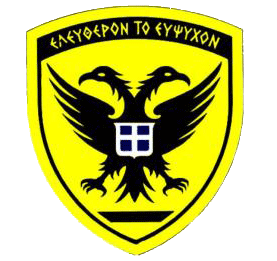Τhe Engineering of the Greek army was first established on the 28th of July 1829. It was first promulgated with the enactment 13559( in the General Greek Newspaper of the 17th August 1829) under the first Greek Government John Kapodistria, has for the first time established the ''Corps of Fortification and Architecture of the Greek army officers'' at Nafplio.
The first chief of the Engineer Corps without troops was the French Captain Garnou who was promoted to Lieutenant Colonel. The Engineer corps was comprised of one French and six Greek officers - engineers who had been trained in Europe. Among them was a major of the French Army Engineering Stamatis Boulgaris, a captain of the Engineer Russian Army Theodoros Valianos, the first Lieutenant of the Prussian Engineer Panagiotis Papanaum and the Engineer major and architect Tilemaxos Vlassopoulos.
The participation of the above in the reconstruction of Greece was great because they have planned and executed important construction works, such as the reconstruction and extension of Nafplio (Voulgaris-Valianos) , the planning of the new city of Patras (Voulgaris), etc. The mission of the Corps was the working out of studies and plans for the construction, the maintenance and the improvement of fort fortifications of army and public buildings , of bridges, streets and other constructions as well as monitoring of their implementation.
In February 1833 the two first sapper companies constituted while on the 1st of August the Engineer has been established as Corps. The Corps was comprised of ex staffing of ''Fort Fortifications and Architecture'' and of two sapper companies. At the same time in every prefecture (except Cyclades) an engineer directorate was established (in a sense the ancestor of today's Directorate of Construction Works) and was assigned to study and implement all the army and public works of the prefecture. Later in 1878, after an enactment the engineer directorates have been abolished. In 1885 the school of Corps was constituted under the title of School of Engineer Regiment.
In 1904 the newly formed army organization has foreseen the future creation of an independent school for Engineer officers, which has functioned inclusively until 1929, under the name of Engineer School. In the period 1912 - 1922, the Engineer participated in all the war operations of that period. In particular during the Asian Minor Campaign due to its hyperefforts the marching on became possible with the assault support of the Greek Army into areas without transport infrastructure.
In 1929, after the adoption of act 4321, referring to the Army organization, the Engineering was included among the five branches of the army (Infantry, Cavalry, Artillery, Engineer and Army Aviation) while the School of Engineer was renamed Applied School of Engineer, located in Athens.
In 1939, with the compulsory act 2125 "Training of staff of army schools and training centers" a reorganization has taken place in the Applied School of Engineer, with the introduction of new training courses.
In 1940 - 41 the Engineer participated successfully in all the operations of the period and with the debacle of the army front and the surrender of the country it followed the same fate of the rest Greek Army. It is important to notice the difficulties faced by the engineer due to lack of machinery and tools necessary to the units for the field fortifications and traffic. The lack of adequate materiel and the relevant lack of transportation means, resulted in the slackening of execution works. The supply of Engineer units in terms of machinery and in particular of the army's battalion, the army's corps and the battalion of road construction, which have not been authorized before the mobilization, had been mobilized after serious predicaments due to mobilization. The variety of models in machinery, the lack of spare parts and the lack of knowledge about their use, were the main reasons of poor results.
In 1942 up until 1944 the ''applied school of Engineer'' reopened in the training center of Ismailia in Middle East, providing to the newly formed Hellenic army the necessary specialized personnel. In October 1944, after the country's liberation, the school was transferred in Goudi (Attika) (in the General training center) while on May 1945 the school was settled in Loutraki in Korinthos and renamed School of Engineer. From this point onward the development of Engineer was parallel to that of the rest of the army.
The Engineer participated actively in all the operations of the civil war and even more actively in the reconstruction of the country, after ten years of war operations and foreign occupation. We will just refer to a report written in 1951 by HAGS for the operation ''Pirsos''. The report says that ''Engineering casualties and its day and night hard working before and during the operation proved fruitless to reduce the performance because everyone (engineering officers and draftees) were well aware of their sensitive and important missions, noiseless as always contributed to the maximum for the victory ".
The operations of recovery - mine clearance of thousands mines laid throughout the Greek State as well as the construction works through the ''Joint Group of Reconstruction Machinery'' constituted an important strengthening to the entire project of country's reconstruction. It should be given emphasis to the important role MOMA (joint group of reconstruction machinery) has played, as a training school of thousand young people who constituted the background for the future country's development of construction industry.
It is worthwhile mentioning the great social and military contribution of Engineering in the establishment of the Service beacon (1910), the Service Cartography (1911, the ancestor of today's Army Geographic Service), the Air Force (1912-13), the Fire Corps (1930) and the Signal Corps (1946).
The contribution of engineer is continuos and present in every country's calamity. The Engineering played the leading part and offered important help through out the testing period- and calamities for the relief of population. The great list of participations of Engineer to the disasters caused by the earthquakes is full of the following data: (1) In Ionian islands in 1953 (2) In Cyclades in 1958 (3) In the area of Ipiros -western Thessaly on may 1967 (4) In Iraklio of Crete on February 1970 (5) In Corinthia on September 1972 (6) In Thessaloniki -Serres -Kilikis- Chalkidiki on June 1978 (7) In Biotia-Korinthia-Attiki-Fokida on February and March 1981 (8) In Messinia in 1987 (9) In Athens on the 7th of September 1999.


